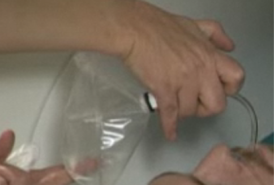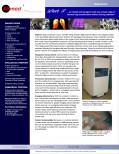- Composition: MagniXene® is Xemed’s hyperpolarized xenon-129 magnetic imaging contrast agent. Xenon is a component of air with a 26.4% natural abundance of isotope 129. MagniXene® begins with xenon that is enriched in isotope 129 to over 80%, but without any appreciable magnetization. Xemed’s proprietary technology enhances the nuclear magnetization by a factor approaching one million times, so that it is visible in an MRI scanner.
- Sustainability: Since MagniXene® is extracted from air, its supply is unlimited. As imaging protocols are demonstrated clinically to be efficacious, production of MagniXene® could scale up to fully address the unmet needs of a large patient population. (In contrast, helium-3 is a scarce resource, presenting an obstacle to widespread commercialization.)
- Production: MagniXene® achieves its high level of magnetization by Spin Exchange Optical Pumping, a process that utilizes a laser beam to optically produce an alignment of the spin axis of rubidium atoms. This alignment of spin is then exchanged to the xenon-129 in a flowing mixture of gases to yield the magnetic enhancement. Xemed’s technology has enabled a scaling up of this process by a large factor, allowing efficient production of multi-liter volumes in as little as ten to twenty minutes.
- Delivery&lifetime: MagniXene® has a useful lifetime that is less than one hour from the time of production. Xemed has developed a compact, automated, and quality controlled production system, the XeBox-E10, which can be located within a magnetic resonance imaging suite. Bags of MagniXene® are produced locally as needed, and used immediately.
- ImagingProtocols: The physiological surroundings of the xenon atoms in MagniXene® modify its physically observable characteristics. By manipulating and observing quantities such as concentration, diffusion, relaxation, chemical shift, and the evolution of these quantities with time, MRI scanner protocols can investigate a broad range of disease-relevant lung properties.
- RegulatoryStatus: Having conducted roughly 300 investigations in 30 subjects, Xemed completed Phase I studies of MagniXene® in December 2006. With an additional 600 investigations in 64 subjects completed since then, Xemed and its academic partners are conducting Phase II pilot studies to assess a few select clinical indications, identify the most promising, and pursue trials for advancement of MagniXene® to Phase III. Xemed and its academic partners are also validating imaging biomarkers of disease to seek FDA qualification of MagniXene® as a Drug Development Tool.
- Safety: Inhalation of a single bag of MagniXene® poses a level of risk that is considered lower than applications involving continuous breathing of xenon (with oxygen). The safety considerations of continuous inhalation of significant xenon concentrations have been studied extensively due to xenon’s past use as a CT contrast agent and its emerging role for maintaining anesthesia. Because neither the MagniXene® nor the examination protocol involves any ionizing radiation, MagniXene® MRI poses a level of risk considered much lower than CT imaging.
- Intellectual Property: Xemed was founded in 2004 to license the hyperpolarized gas intellectual property portfolio from the University of New Hampshire, and to use that technology to scale up production of hyperpolarized xenon-129 to make it useful for human imaging. Inventions by other inventors related to gas hyperpolarization date back to 1996 and earlier. Xemed’s research to advance MagniXene® is sanctioned as non-infringing of other patents by FDA safe-harbor laws. Following FDA approval, a freedom to practice assessment and consolidation of IP will precede commercial sales and marketing.
- MagniXene Imaging Network: Xemed conducts pilot studies and clinical trials in partnership with scientists, radiologists, pulmonologists, and statisticians at academic teaching hospitals.
- DrugDevelopment: Xemed seeks partnerships with pharmaceutical companies in the development of quantitative pulmonary imaging biomarkers for validation as FDA-qualified Drug Development Tools.
- Commercialization&Costs: Xemed projects MRI examination costs with MagniXene® will likely exceed exams with gadolinium chelate contrast, but should be considerably lower than positron emission tomography. The cost of a xenon hyperpolarizer should be a small fraction of the cost of an MRI scanner, while extending their utility to include lung disease, a leading cause of mortality and morbidity.
- Commercial Potential: The US market for MRI scanners was $1.4B in 2005, with roughly 700 units sold. 9000 MRI scanners are in use worldwide. The global market for imaging contrast agents was $5.4B in 2008, expected to grow to $7.9B by 2015. Xemed projects MagniXene® revenues exceeding $100M on 300,000 examinations annually, supporting annual sales of 100 polarizer units by 2022. Expanding the market for contrast agents by 1.3%.

Imagine a pulmonary imaging agent derived from a natural component of air that can map out characteristics of lung functional microstructure, including the smallest airways, alveolar septal walls, and capillaries, via the same gas exchange pathways as inhaled air.
Imagine MagniXene®.
Images… from the air we breathe.
